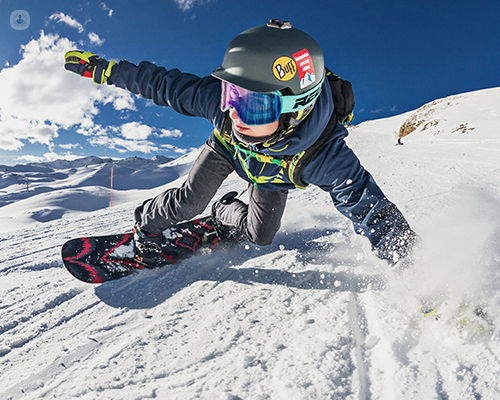Platelet rich plasma for sports injuries
Escrito por:The production of plasma rich in platelets and growth factors began back in the early 70s. In 2009, two Pittsburgh Steelers received PRP injections for ankle injuries before they won their game at the Super Bowl. Orthopaedic surgeon Mr Georgios Arealis tells us more about how PRP can be used to treat sports injuries.

Firstly, platelet rich plasma (PRP) can be defined as a fraction of autologous blood (obtained from the same person) with a large concentration of platelets. A typical blood specimen comprises of 93% red blood cells, 6% platelets and 1% white blood cells. PRP has almost no red blood cells, 90% is platelets and there can be a varying number of white blood cells. Once activated, platelets release growth factors and proteins, which can be used to heal and repair wounds and damaged tissues. This is the role of platelet rich plasma, which is prepared in a laboratory setting.
Uses of PRP
Platelet rich plasma injections can be used to treat a variety of sports conditions, including the following:
- Elbow epicondylitis : tennis elbow (lateral epicondylitis) and golfer’s elbow (medial epicondylitis). PRP injections have a 90% success rate in treating tennis elbow.
PRP injections significantly reduce post-operative pain. In one study, 93.6% of patients who received PRP stopped taking painkillers or took them occasionally (paracetamol) three weeks after the injection. However, 57% of patients who didn’t receive PRP were still on painkillers after three weeks.
- Shoulder sub-acromial impingement : patients who are not suitable to be operated on due to co-morbidities, for example, can be treated with PRP therapy.
- Rotator cuff tears and repairs.
- Shoulder osteoarthritis and osteochondral lesions; in six studies by Meheux et al with 739 patients, PRP injections significantly improved symptomatic osteoarthritis in patients 12 months after the injections.
- Reconstruction of ligaments : AC joint reconstruction and sternoclavicular joint reconstruction.
- Patellar tendinopathy ; all studies using PRP to treat this condition show improvements after nine months, following one to three injections.
- Muscle injuries ; a randomised study of 30 male Ukrainian athletes compared PRP treatment with conventional conservative therapy for acute muscle injuries. The PRP group experienced faster pain relief, improved muscle function and better range in motion after treatment. They also returned to sports ten days after PRP treatment, in comparison to 22 days for those in the control group.
Who is not suitable for PRP?
Anyone with any of the following is not suited to PRP treatment:
- Platelet dysfunction syndrome
- Critical thrombocytopenia
- Infection at the procedure site
- Septicaemia
- Pain, nerve damage or bleeding at the injection site
Treatment can also be withheld if the patient:
- Has been using NSAIDs within 48 hours of the PRP procedure
- Has cancer of the bone
- Uses tobacco extensively
- Has had a recent illness or fever
- Has used corticosteroids within the last two weeks
Risks of PRP treatment
As with any treatment, there are always some risks involved. Patients may experience infection, some bleeding, nerve damage and pain.
According to NICE, using an autologous blood injection for tendinopathy raises no major safety concerns. However, as there is still little evidence about the efficacy of this treatment, it should only be carried out under special conditions.
The World Anti-Doping Code (WADA) publishes a list of prohibited substances every year. The prohibition for intramuscular injections of PRP was removed from the list in 2011, so it is now acceptable to administer PRP injections into muscles.
It’s still advised to proceed with caution in the use of PRP in athletic sporting injuries, as it is a relatively new treatment, but if carried out under the supervision of an orthopaedic specialist, there is little risk involved.
If you’d like to speak about how platelet rich plasma can help you and your sporting injuries, you can get in touch with Mr Georgios Arealis for more information.


